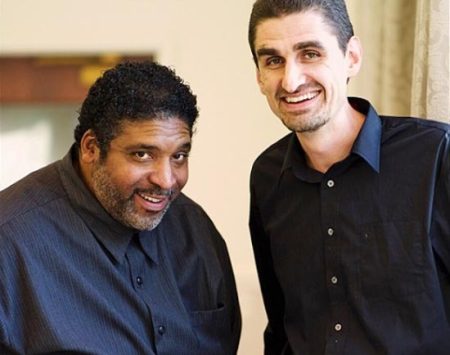What Kind of American Are You?
The scientific method; Iran; Racism vs DEI; A Tale of Two Generals;

by Errington C. Thompson, MD –
It appears that many Americans don’t understand the scientific method.
The scientific method allows researchers to test a theory or hypothesis to determine if it’s true. For example, let’s say that we have been treating patients with colon cancer. A pharmaceutical company has developed a new drug, and they believe this new drug will improve survival in patients with colon cancer.
Now, we test that theory. We need two groups of patients: one group would get the standard therapy for colon cancer, and the second group would get the standard treatment plus this new drug. Of course, both groups of patients must agree to participate in the study and understand that it is an experiment. Then, patients are studied for one year, two years, and perhaps as many as five years. The data is analyzed using statistics to determine if survival rates at one, two, and five years are the same, better, or worse with this new drug.
The doctors who conducted the study need to write up a clear and concise report. The report must include as many pertinent details about the drug as possible. This would include the drug’s side effects, which were observed during the clinical trial. And the authors must also disclose that the pharmaceutical company funded the trial, as this connection introduces potential bias.
This is the scientific method in a nutshell. You have a hypothesis. You design an experiment to prove your hypothesis. You analyze your data using appropriate statistics. Then, you see if your analysis supports or refutes your hypothesis.
The scientific method is a powerful tool for proving—or disproving—a theory. It’s especially important and valuable in matters of scientific and medical research. I truly wish someone would explain the scientific method to Robert F Kennedy, Jr., who, it seems, starts with a conclusion and then tries to formulate data around his pre-formed conclusion.
Iran
Earlier this summer, we—the United States (well, President Trump)—decided, with almost no national discussion, that we would bomb Iran with 30,000-pound bunker-busting bombs. It was almost comical how quickly “we” made this decision. Donald Trump, who is notoriously poor at making important decisions, initially stated that he would take two weeks to consider the problem. Two days later, The New York Times reported that we had bombed Iran and its three nuclear sites.
For those of us with gray hair, this was déjà vu all over again. In the run-up to the war with Iraq, Gen. Colin Powell gave a presentation to the nation. He presented an extensive array of information to make the case that Iraq had weapons of mass destruction. “Iraq was obtaining yellowcake uranium from Niger.” Iraq had also received these particular aluminum tubes, which “could be used ‘only’ for a uranium centrifuge.” Oh, and let us not forget that Iraq had these mobile labs so Saddam Hussein could “launch a devastating chemical, biological weapon against the EU or even Britain without a moment’s notice.” Because the labs were mobile, it would be difficult, if not impossible, to determine their exact location.
So, of course, under President George W. Bush, we invaded Iraq. We toppled Saddam Hussein. What was the result? We did not find weapons of mass destruction. There was no yellowcake. A highly experienced CIA agent was outed by Vice President Cheney, destroying her entire network of spies (“humint,” or Human Intelligence). The entire case presented to the American public was almost 100% incorrect.
Some 20 years after the Iraq war, Donald Trump, I guess, decided that he did not need to make a case in front of the American people regarding Iran. He did not need to go to Congress. He did not consult the intelligence community or military experts. Instead, he discussed his plans with his top military advisers, all of whom were handpicked yes-men, chosen by him basically because they “looked the part.” These unqualified men quickly decided there was enough evidence to attack. They decided to act. And they decided that the mission was successful. We have been told that Iran no longer presents a threat to its neighbors.
Let’s remember that this crisis dates back to Donald Trump’s first term in office. He was the one who tore up the international agreement—painstakingly negotiated by President Obama and the French, Germans, British, and Iranians—that seemed to have Iran’s nuclear program under control.
Trump never replaced the deal with anything; he just unilaterally abrogated it. Therefore, Iran was free to develop nuclear weapons as it chose. Please, don’t believe for a moment that Iran’s nuclear program was “obliterated.” It is crucial for us to remember what it takes to make a nuclear bomb in 2025. You need money. You need facilities to build your nuclear weapon. You need to have uranium. You need scientists who are skilled in atomic physics—but remember, this is not the 1940s. You don’t need Oppenheimer. The science has already been worked out. Therefore, you simply need educated scientists.
Ultimately, you must possess the political will or desire to become a nuclear power. Iran seems to have all these ingredients. At best, it seems to me, that this bombing has set Iran back six months, maybe as much as 36 months. But it is naïve for us to think that Iran is going to walk away from their nuclear ambitions because somebody bombed their facilities.
Racism vs DEI
The United States has been a racist country. This fact should come as no surprise to anyone. But the extent of racism is somewhat overwhelming when you try to investigate it. When you ask simple questions like, “Why are there ghettos?” the answer is extremely ugly.
FDR’s New Deal was taught to us in middle school, and it was a series of laws that helped move America out of the Great Depression. What we weren’t told is that the very statutes that helped propel White America out of the Depression pushed Black America into segregated housing.
For example, the Federal Home Loan Bank provided low-interest loans to both developers and homeowners. It was the precursor to FHA. From the 1930s through the mid-1960s, it had a policy of not offering low-interest loans to Americans who were non-white. This meant, especially after World War II, when America went through this huge housing boom, that Blacks, Hispanics, and Native Americans were all excluded from this bonanza.
As a matter of fact, if you moved to one of the large cities, you were forced into substandard housing if you were a minority. Banks would not loan you money to live in the nice neighborhoods (this was called redlining). You could get a high-interest loan to live in substandard housing, though.
But what does all this mean? Isn’t this all ancient history?
While white Americans were allowed to accumulate wealth with low-interest loans, minorities, who made less money, were unable to accumulate almost anything. Remember that Black Americans were locked out of high-paying jobs. Managerial jobs. Shift supervisor jobs. Executive jobs. Those positions were, for the most part, held by white individuals until the late 1960s.
The only way to balance the scales is to push diversity. We want to ensure that everyone has a fair chance. We have to keep in mind our history of racism as we move forward. Balancing the scales does not mean excluding Whites as we move forward. Instead, it means including Blacks, Hispanics, women, and Native Americans. Try to include as many qualified Americans as we can. This is how we move forward.
A Tale of Two Generals
John Bell Hood was born in Kentucky. He went to West Point. When the Civil War broke out, he joined the Confederacy. He was part of Robert E Lee’s Army of Northern Virginia. He distinguished himself at Gettysburg and again at Chickamauga. He was promoted to General when he was only 34 years old. He was severely injured, requiring an amputation of his leg at Chickamauga. He was chosen by Confederate President Jefferson Davis to replace Joseph Johnston, who was ineffective in the Battle of Atlanta.
Unfortunately, Hood decided to attack a superior force not once, not twice, but four separate times, which resulted in heavy Confederate casualties and did nothing to stave off Sherman’s eventual victory and capture of Atlanta. Hood performed so poorly in the subsequent Battle of Franklin as well as the Battle of Nashville that he relieved himself of command. So, why would you want to name a military installation, an essential fort, after a “failed” Confederate general?
Richard Edward Cavazos was born in Kingsville, Texas. He attended North Texas Agricultural College, where he joined ROTC. He then transferred to Texas Technological College and earned a Bachelor of Science degree in geology. After graduating from college in 1951, he joined the Army as a second lieutenant during the Korean War. He commanded the second Battalion, 65th Infantry Regiment. He earned the Silver Star for his actions, as well as the Distinguished Service Cross—which was posthumously upgraded to the Medal of Honor.
What was Cavazos’s record? It seems that he led his company through intense enemy fire to clear an enemy outpost. At the same time, he evacuated injured soldiers despite being injured himself. During the Vietnam War, he held the rank of Lieutenant Colonel. He earned another Distinguished Service Cross for his valiant leadership at Loc Ninh. He was promoted to Brigadier General after the Vietnam War. In 1982, 31 years after joining the Army, he was promoted to four-star general, becoming the first Hispanic to achieve this rank.
Under President Joe Biden, Fort Hood was renamed “Fort Cavazos.” You can call this a DEI move if you want, but it seems to me that General Cavazos had an exemplary career. In contrast, Joseph Hood was, literally, a traitor to his country by joining the Confederate Army in the Civil War. Now, President Trump has renamed the fort “Fort Hood” under the pretense that the renaming honors Col. Robert Hood, a hero of World War I.
If your son or daughter joined the Army, you would like him or her to have a career similar to General Cavazos, wouldn’t you? He was heroic, without trying to be a hero, just a patriotic soldier devoted to his country. No DEI was ever needed: he earned his reputation as the kind of officer who made everyone want to stand up and salute. But he was Hispanic, and therefore persona non grata in the world of Donald Trump.
Finally, if you genuinely believe in Jesus Christ, then you believe in DEI. Christ invited everyone to sit at his table. Christ accepted the least among us. Christ never asked, “What can I do for the rich and powerful?” Instead, he said that the meek will inherit the earth. Remember that God has asked us to love one another. This means Universal Healthcare. This means we have to do something about gun violence. (I’m still shocked and deeply saddened by the political assassination in Minneapolis a few weeks ago. That should never happen in an advanced society.)
So, what kind of American are you? Are you going to embrace hate? Or are you the kind of American who is going to embrace love?
NOTE: The views and opinions expressed here, as well as assertions of facts, are those of the author. They do not necessarily represent the views or opinions of The Urban News.








